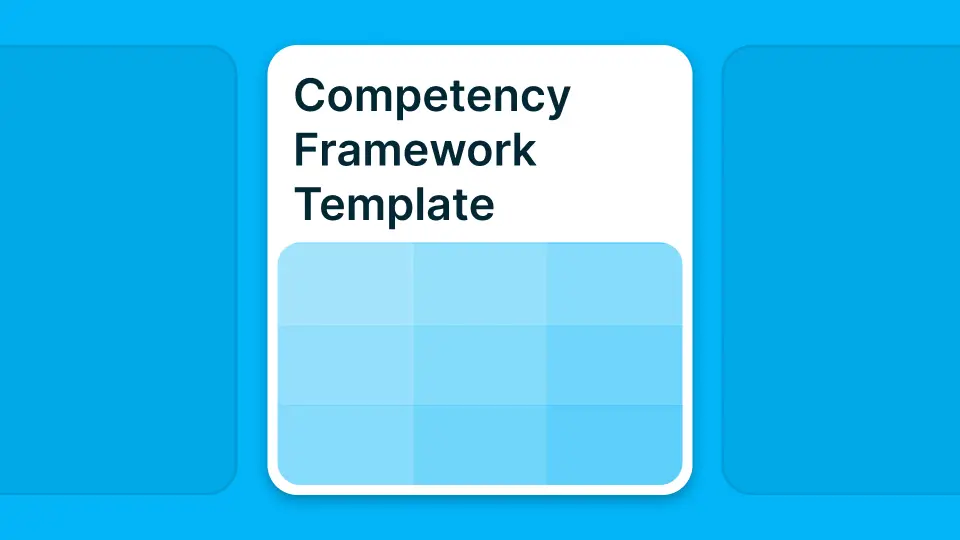Only 27% of CS leaders have a clear view of the skills needed at each role level in their teams. That's according to recent Gainsight research—and it explains why so many customer success organizations struggle with inconsistent performance, unclear promotion paths, and frustrating calibration debates.
A well-built customer success skills matrix template changes all of that. It gives you a structured roadmap for hiring, developing, and promoting with confidence—across CSMs, Senior CSMs, CS Ops specialists, and Managers. Instead of relying on gut feeling or generic checklists, you get clear behavioral anchors, evidence-based assessments, and segment-specific frameworks that reflect your actual business reality.
In this guide, you'll discover how to build and use a customer success skills matrix template that drives real team performance. We'll walk through role-based matrices covering SMB, mid-market, and enterprise needs. You'll see proven competency families—from onboarding and QBRs to renewals, stakeholder management, and health scoring. We'll share downloadable templates in Excel, Google Sheets, and Notion formats, plus practical assessment workflows and calibration tips that eliminate subjectivity.
By the end, you'll know exactly how to map critical competencies, measure proficiency with behavioral examples, avoid common pitfalls like activity-over-outcome scoring, and leverage AI-powered tools to surface gaps faster. Whether you're scaling a startup CS team or standardizing practices across a global organization, this framework will help you make better talent decisions every quarter.
1. Understanding the Customer Success Skills Matrix Template
A customer success skills matrix template is more than a checkbox list. It's a dynamic tool that maps the critical competencies needed at every CS role and level—turning vague expectations into clear development paths. Studies show that companies using role-based skill matrices see up to 19% higher employee engagement, according to the LinkedIn Workplace Learning Report 2023. Yet only 27% of organizations actually map skills by role level, Gartner research reveals.
Consider a SaaS startup expanding rapidly across Europe. Before implementing a tailored CS skills matrix, onboarding took four months and new hires often felt lost. After building a structured template with clear competency definitions, ramp time dropped by 30% and confidence scores in first-quarter surveys jumped significantly. The difference? Everyone knew exactly what "good" looked like at each stage.
Building an effective matrix starts with defining core skill families before you touch any spreadsheet. Include all relevant roles—CSMs, Senior CSMs, CS Ops, Managers—and use clear criteria instead of vague task lists. Your matrix should reflect real work, not theory. Keep it living: update quarterly as products, markets, or customer needs evolve.
| Role Level | Core Skill Family | Example Skill |
|---|---|---|
| CSM | Onboarding | Project planning |
| Senior CSM | Renewal/Upsell | Commercial acumen |
| CS Ops | Process Automation | Workflow design |
| CS Manager | Data Analysis | Health scoring |
For collaborative editing and version control, tools like Google Sheets or Notion work well. Many teams start with a simple Excel template and migrate to a shared platform once the framework is tested. The key is accessibility—your matrix should be easy for managers and team members to reference during one-on-ones, performance reviews, or career planning conversations.
Once you know what belongs in your template, the next question is which specific competencies matter most—and how they vary by customer segment and business model.
2. Competency Families Across Customer Success Roles
The most effective customer success skills matrix templates break down skills into focused competency families. This makes development transparent and actionable. CS teams that assess by competency family drive 25% more consistent renewal outcomes, according to TSIA Research. High-performing teams review at least six skill families per role, the Totango State of CS Report shows.
A mid-market B2B tech company overhauled its annual reviews by defining eight core competency families. Within one year, Net Revenue Retention improved measurably—not because they hired more people, but because expectations became clear and training aligned with actual gaps. Managers knew which skills to coach, and team members understood exactly what progression required.
Start by identifying universal families that every CS professional needs: onboarding, QBRs/EBRs, account planning, and communication. Then add advanced areas for senior roles and managers: risk management, product adoption analytics, data interpretation, and strategic account expansion. Tailor stakeholder management for enterprise segments where exec alignment matters. Include collaboration competencies—how your CS team works with Sales, Product, and Support—because silos kill retention.
| Competency Family | Role Example | Key Behaviors |
|---|---|---|
| Onboarding | CSM | Drives time-to-value, completes kickoffs on schedule |
| QBRs/EBRs | Senior CSM | Facilitates executive reviews, tracks outcomes |
| Renewal/Upsell | Senior CSM | Identifies expansion signals, closes renewals |
| Risk Management | CS Ops | Monitors health scores, escalates early |
| Data Analysis | Manager | Interprets health metrics, forecasts churn |
| Stakeholder Management | Enterprise CSM | Builds exec relationships, influences decisions |
Use behavioral anchors for each family—specific statements that describe "what good looks like" at different levels. For example, under Onboarding at Level 1, a CSM might complete standard kickoff calls. At Level 3, they customize onboarding plans based on customer goals. At Level 5, they design scalable onboarding playbooks that others can replicate. This granularity removes guesswork and creates fair promotion criteria.
Segment matters too. Enterprise CS roles prioritize executive alignment and strategic account planning. SMB-focused CSMs need stronger process automation and efficiency skills to manage higher volumes. Mid-market roles often blend both. Your competency families should reflect these realities rather than force-fit a one-size-fits-all framework.
Now that you know which competencies to include, the challenge shifts: how do you measure progress objectively across those families?
3. Building a Proficiency Scale with Behavioral Examples
An effective customer success skills matrix template uses clear proficiency levels—each backed by real-world behaviors—to ensure fair assessment. Competency models with behavior-based scales reduce subjective ratings by up to 40%, Harvard Business Review research shows. Companies using evidence-backed skill levels see promotion accuracy rise by 18%, according to Mercer Global Talent Trends.
A global SaaS leader moved from simple "yes/no" skill checks to a five-point scale with specific examples at each level. Managers reported fewer calibration disputes and more confident development conversations. Team members appreciated knowing exactly what they needed to demonstrate for promotion—not just vague advice to "get better at stakeholder management."
Use scales from 0–4 or 1–5 and define each level with specific outcomes, not just effort. Write behavior statements that anyone can observe: "Consistently leads EBRs with C-level executives" or "Designs adoption playbooks used by the full team." Add an evidence field where the employee or manager can note proof—documents, screenshots, customer feedback, closed deals, or meeting notes. This transforms abstract ratings into concrete conversations.
| Skill | Level 1 Example | Level 3 Example | Level 5 Example |
|---|---|---|---|
| Stakeholder Management | Updates contacts monthly | Builds exec relationships, schedules QBRs | Influences board-level deals, shapes roadmap |
| Product Adoption | Shares help articles | Runs adoption workshops, tracks usage | Designs adoption playbooks, mentors others |
| Risk Management | Reports red accounts | Identifies early warning signals | Builds predictive risk models |
| Commercial Acumen | Knows pricing basics | Identifies upsell opportunities | Negotiates contract terms independently |
Calibrate across managers to avoid bias. One manager's Level 3 might be another's Level 4 if you don't align definitions upfront. Schedule regular calibration sessions where managers share examples and debate edge cases. This builds shared understanding and reduces rating inflation over time.
Keep language simple but precise. Avoid jargon that only senior leaders understand. Your matrix should be readable by a new CSM on day one. If someone needs three paragraphs to understand a single behavior, rewrite it. Clarity beats complexity every time.
Sprad's Atlas AI can suggest behaviors based on aggregated industry data from over 32,000 mapped skills. This accelerates template creation and helps surface blind spots—skills your team needs but hasn't explicitly named yet. The platform can also track evidence automatically if integrated with your performance system, saving managers hours of manual documentation.
With clear scales in place, the next step is putting assessment into action. How do you run fair, consistent reviews without endless debates?
4. Assessment Workflow & Calibration Best Practices
A robust workflow keeps your customer success skills matrix template fair and ensures everyone knows what "good" looks like at each stage. Teams using peer calibration report up to 23% greater consistency in evaluations, Gartner HR Research shows. Calibration reduces promotion bias incidents by over one-third, according to Deloitte Human Capital Trends.
A North American SaaS scale-up held quarterly calibration sessions for all CS managers. Within two cycles, rating discrepancies between managers dropped by half. Team members noticed—and trust in the promotion process increased significantly. The secret? Structured workflows and transparent decisions.
Train all reviewers on how to interpret scales and behaviors before the first assessment cycle. Run a practice round where managers rate the same hypothetical CSM and compare results. Discuss differences openly and align on evidence standards. This upfront investment prevents confusion later.
Schedule regular calibration meetings across teams. Bring managers together to review ratings, share examples, and challenge outliers. If one manager consistently rates higher or lower than peers, dig into why. Are they interpreting behaviors differently? Do they have access to better evidence? Calibration isn't about forcing uniformity—it's about shared understanding.
| Workflow Step | Owner | Frequency |
|---|---|---|
| Initial Self-Rating | Employee | Quarterly |
| Manager Review | Direct Manager | Quarterly |
| Peer Input Collection | Team Leads | Quarterly |
| Calibration Session | Management | Biannual |
| Development Plan Update | Manager + Employee | Quarterly |
Collect multiple sources of evidence per skill. Self-ratings alone aren't enough—people overestimate or underestimate their abilities. Manager observations add perspective but can miss day-to-day nuances. Peer feedback reveals collaboration strengths and blind spots. Customer feedback highlights impact but can be subjective. Combine these sources for a complete picture.
Document decisions transparently in your template or platform. If someone asks why they received a Level 3 instead of Level 4 for stakeholder management, you should be able to point to specific evidence and agreed-upon standards. Transparency builds trust and reduces appeals.
Encourage open feedback loops between staff and managers. If a CSM disagrees with a rating, create space for discussion. Maybe they have evidence the manager didn't see. Maybe the manager observed something the CSM didn't realize. These conversations improve accuracy and strengthen relationships.
Digital platforms can automate parts of the workflow—reminders, evidence collection, rating aggregation—reducing admin burden so managers can focus on coaching. Sprad's Atlas AI, for example, can pull performance data automatically and flag gaps without manual spreadsheet wrangling.
Now that you have a fair assessment process, how do you adapt your matrix for different customer segments—SMB, mid-market, and enterprise?
5. Segment-Specific Matrices: SMB vs. Mid-Market vs. Enterprise
Customer success isn't one-size-fits-all. Matrix templates must adapt to segment realities like deal complexity, resource depth, and customer expectations. Enterprise CS organizations report different top required skills than SMB teams—for example, executive stakeholder management versus process automation, according to Forrester CX Trends.
60% of enterprise CS leaders cite account planning as critical. Only 32% of SMB leaders agree, the ChurnZero Benchmarking Study reveals. Why? Enterprise accounts have longer sales cycles, more stakeholders, and higher revenue at risk. SMB customers need fast onboarding and self-service tools. Your skills matrix should reflect these differences.
An enterprise software vendor split its skill matrices by segment and unlocked clearer career paths. CSMs could see exactly what skills they needed to move from SMB to mid-market, or from mid-market to strategic accounts. Internal mobility improved because expectations were no longer generic.
Map unique requirements per segment in separate tabs or templates. Prioritize commercial acumen and strategic planning for enterprise roles. Focus on automation, process efficiency, and volume management for SMB teams. Mid-market often blends both—CSMs need enough strategic thinking to engage multiple stakeholders but also the operational discipline to handle ten or twenty accounts.
| Segment | Must-Have Skill | Behavior Example |
|---|---|---|
| SMB | Process Automation | Sets up workflow triggers, scales onboarding |
| SMB | Self-Service Enablement | Creates help center content, reduces tickets |
| Mid-Market | Expansion Opportunity ID | Spots upsell in usage trends, engages buyers |
| Mid-Market | Cross-Functional Collaboration | Coordinates with Sales and Product |
| Enterprise | Executive Alignment | Hosts board-level QBRs, influences strategy |
| Enterprise | Account Planning | Builds multi-year roadmaps with stakeholders |
Adjust evidence fields based on segment complexity. For SMB, evidence might be usage metrics or NPS trends. For enterprise, look for meeting notes with C-level executives, strategic planning documents, or contract renewals above a certain threshold. The standards should be rigorous but realistic for each segment's day-to-day work.
Review matrices regularly as market needs shift. A skill that mattered two years ago might be less critical today. New product features or competitive pressures can change priorities overnight. Quarterly or biannual reviews keep your framework relevant.
Segment-specific matrices also improve hiring. When you post a "Senior CSM—Enterprise Accounts" role, candidates see exactly which competencies you value. No more vague job descriptions that attract the wrong applicants. Clear expectations attract the right talent and accelerate onboarding.
Even with the best framework, mistakes happen. What are common pitfalls when applying these matrices—and how can you avoid them?
6. Common Pitfalls & How To Fix Them
Many CS leaders fall into the trap of measuring activity over outcomes—or relying too much on subjective client praise when assessing skills. Organizations focusing on outcomes instead of actions report up to double the improvement in NPS scores post-matrix rollout, according to the Gainsight Pulse Survey. Yet 41% of companies admit their current assessments are too subjective, the SkillSurvey HR Analytics Report reveals.
A fintech firm realized "client thank-you emails" were skewing ratings. CSMs who sent polite follow-ups scored higher on stakeholder management than those who actually closed renewals. After shifting focus to retention metrics as evidence—contracts renewed, expansion revenue, churn prevented—renewal rates improved by 15% within two quarters.
Distinguish between activity and outcome. "Ran a QBR" is an activity. "Renewal closed after addressing risks identified in QBR" is an outcome. Your proficiency scales should reward results, not just effort. A CSM who completes every onboarding task on time but sees low adoption hasn't mastered onboarding—they've checked boxes.
Use multiple data points beyond client feedback. Customer satisfaction matters, but it's only one signal. Some clients praise CSMs who are responsive but don't challenge them. Others complain loudly even when outcomes are strong. Balance qualitative feedback with quantitative metrics: usage data, health scores, renewal rates, upsell closed, tickets resolved, time-to-value.
| Pitfall | Impact | Fix |
|---|---|---|
| Activity > Outcome | Inflated scores, missed development needs | Tie behaviors to measurable results |
| Subjective Feedback Only | Inconsistent ratings, bias | Standardize evidence requirements |
| Rare Calibration | Rating drift, unfair promotions | Hold quarterly or biannual sessions |
| Static Matrices | Outdated skills, irrelevant assessments | Review and update quarterly |
Regularly audit for rating inflation or bias. If every team member gets Level 4 or 5, your scale isn't working. Either standards are too loose or managers fear difficult conversations. Anonymous surveys can reveal whether employees trust the process. If trust is low, dig into why and fix it.
Calibrate definitions annually as business goals evolve. A skill that was "advanced" two years ago might be table stakes today. Markets shift. Technology changes. Customer expectations rise. Your matrix must keep pace or it becomes a compliance exercise instead of a development tool.
Involve non-CS stakeholders in review processes where possible. Ask Sales leaders to weigh in on collaboration skills. Get Product feedback on how well CSMs communicate customer needs. This cross-functional input reduces blind spots and improves accuracy.
Download audit checklists and calibration guides to keep your assessments honest. Tools like Sprad's Skill Gap Analysis Template help identify patterns across teams—like consistent underperformance in a specific competency family—so you can address root causes instead of treating symptoms.
Finally, how do modern AI tools supercharge these matrices and help you scale without adding headcount?
7. Leveraging AI & Taxonomies Like Sprad Atlas AI
AI-powered platforms like Sprad's Atlas AI transform static matrices into living frameworks. Smart suggestions drawn from thousands of global benchmarks help you identify gaps faster and close them with precision. Firms leveraging large-scale taxonomies find gaps twice as fast and close them up to four months sooner than manual approaches, according to a McKinsey Digital Skills Study.
Atlas AI draws from over 32,000 mapped skills across industries for precise recommendations. An international SaaS provider used the gap analysis feature and surfaced hidden weaknesses in stakeholder management among senior CSMs. Targeted training followed—and retention KPIs lifted within one quarter. The difference? Data replaced guesswork.
Import existing matrices directly into platforms like Sprad or Notion. The system auto-suggests missing or emerging skills based on job family data. If your CS Ops team lacks process optimization competencies that peers have, Atlas AI flags it. If new product features require analytics skills your team doesn't have yet, you see the gap before it hurts performance.
Visualize gaps across teams or individuals instantly. Heatmaps show which competency families need development at a glance. Managers can prioritize training budgets and coaching time on skills that matter most. No more spreadsheet diving or manual comparisons.
| Feature | Benefit | Example Use Case |
|---|---|---|
| Auto-Skill Suggestion | Covers blind spots | Recommends "risk mitigation" for new vertical |
| Gap Visualization | Clear priorities | Highlights lack of health scoring expertise |
| Evidence Tracking | Reduces admin burden | Pulls performance data automatically |
| Calibration Support | Fairer assessments | Flags rating outliers for manager review |
Sync updates automatically as roles evolve or new products launch. When your product team ships a major feature, Atlas AI can update relevant CS competencies in real time. No waiting for quarterly reviews—your matrix reflects current reality immediately.
Export actionable reports for HR and talent management partners. Show which teams are ready for internal mobility. Identify high-potential employees who could move from SMB to enterprise accounts. Forecast skill shortages before they become hiring crises. AI turns your skills data into strategic workforce planning.
Integration with performance review tools means managers don't juggle multiple systems. They see skill assessments, development plans, and one-on-one notes in one place. This reduces admin burden and improves consistency across the organization.
Sprad's talent management platform connects skill matrices to career frameworks, succession planning, and learning paths. When a CSM wants to grow into a management role, the system shows exactly which skills they need and recommends training resources. Development becomes self-directed instead of top-down.
Now let's recap what matters most and how you can get started today.
Conclusion: Building a Future-Proof Customer Success Team Starts With Smart Skills Mapping
A well-designed customer success skills matrix template empowers fair development conversations—not just compliance checks. Segment-specific matrices ensure you're building the right strengths for your unique customers. Objective measures plus smart tooling remove guesswork from hiring and promotions.
The most effective frameworks share three qualities. First, they use behavioral anchors at every proficiency level so expectations are crystal clear. Second, they distinguish between activity and outcome—rewarding results, not just effort. Third, they evolve regularly as markets, products, and customer needs shift.
Start by downloading a template tailored to your main segments. Run an initial self-assessment cycle using clear behavioral anchors. Schedule your first cross-team calibration session this quarter to align standards and build trust. Collect multiple sources of evidence—self-ratings, manager observations, peer input, customer data—for a complete picture of each team member's strengths and gaps.
As customer expectations rise and products diversify further, continuously evolving your skills framework becomes essential. Platforms like Sprad's Atlas AI accelerate this process with auto-suggestions from over 32,000 mapped skills, instant gap visualization, and automated evidence tracking. This turns static spreadsheets into living development tools that scale with your team.
The companies winning in customer success don't rely on generic checklists or gut-feel promotions. They build transparent, evidence-based skill systems that attract top talent, develop existing teams faster, and create clear paths for growth. Your matrix is the foundation for all of that.
Frequently Asked Questions (FAQ)
What is a customer success skills matrix template—and why does it matter?
A customer success skills matrix template is a structured chart that lists key competencies needed at each CS role level—from CSMs through managers—with clear performance standards. It helps you hire better talent and develop existing team members effectively by replacing vague expectations with specific behavioral anchors. Organizations using role-based skill matrices see up to 19% higher employee engagement and significantly faster onboarding. Without a matrix, promotion decisions feel arbitrary and development conversations lack direction.
How do I structure competency families within my CS matrix?
Start with broad categories such as onboarding, QBRs/EBRs, renewal/upsell, risk management, stakeholder management, and data analysis. For each family, list the specific behaviors expected at different proficiency levels—Level 1 through Level 5, for example. This makes it easier to track growth and target development efforts. High-performing teams review at least six competency families per role and update them quarterly as business needs change. Use behavioral examples like "facilitates executive reviews" instead of generic phrases like "good communicator."
What's the best way to assess renewals or upsell-related skills?
Combine outcome-based metrics like "renewal closed" or "expansion revenue generated" with observed behaviors such as "identified expansion opportunity during EBR" or "addressed pricing objections with data." Ask both peers and managers for supporting evidence—not just client feedback—for balanced assessments. Client praise is one data point, but it can be subjective. Look at usage trends, health scores, contract values, and time-to-close for more objective measures. Evidence fields in your matrix should capture all of these sources so ratings are defensible.
How should weighting work when evaluating different skill areas?
Weightings depend on business goals and customer segments. For example, prioritize executive relationship-building and strategic account planning in enterprise segments where deals are complex and stakes are high. Process automation and efficiency might matter more in SMB-focused teams managing higher volumes. Review weightings annually as strategy shifts—what was critical two years ago may be less important today. Some organizations use different matrices per segment to avoid awkward compromises. Others keep one matrix but adjust evidence thresholds based on role focus.
Can I use digital tools or AI platforms with my skills matrix?
Absolutely. Modern tools like Sprad's Atlas AI can auto-suggest missing competencies from a taxonomy of over 32,000 mapped skills, visualize gaps across teams, sync updates automatically as roles evolve, and export actionable reports for HR partners. This saves time while improving accuracy across distributed teams. Digital platforms also reduce admin burden—pulling performance data, tracking evidence, and flagging rating outliers—so managers can focus on coaching instead of spreadsheet wrangling. Integration with ATS and performance systems means one source of truth for all talent decisions.












